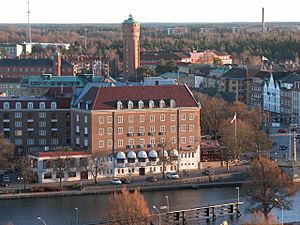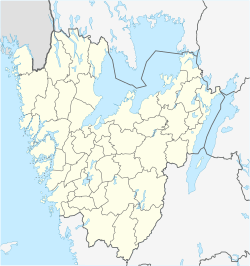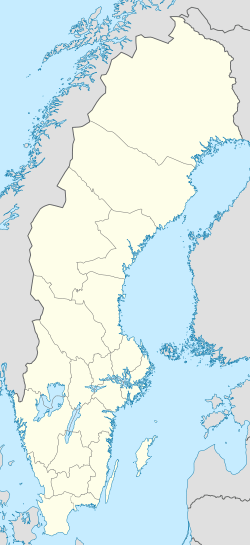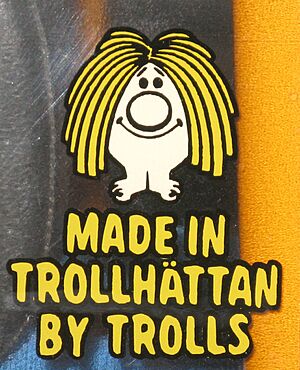Trollhättan facts for kids
Trollhättan is the 23rd-largest city in Sweden. It is the main town of the Trollhättan Municipality in Västra Götaland County. The city is located by the Göta älv river, close to Lake Vänern. About 50,000 people live in the city itself. Trollhättan is about 75 kilometers (46 miles) north of Gothenburg, which is Sweden's second-largest city.
Quick facts for kids
Trollhättan
|
|
|---|---|

The Göta älv river and Trollhättan Water Tower in central Trollhättan
|
|
| Country | Sweden |
| Province | Västergötland |
| County | Västra Götaland County |
| Municipality | Trollhättan Municipality |
| Area | |
| • Total | 23.78 km2 (9.18 sq mi) |
| Population
(30 November 2021)
|
|
| • Total | 59,210 |
| • Density | 1,954/km2 (5,060/sq mi) |
| Time zone | UTC+1 (CET) |
| • Summer (DST) | UTC+2 (CEST) |
Contents
History of Trollhättan
Trollhättan became a city in 1916. At that time, about 15,000 people lived there. Today, the population has grown to over 59,000.
The city started on the Göta älv river, right by the Trollhättan Falls. People first wrote about this place in 1413. Trollhättan was an important stop on the way between Västergötland and Norway. It was also key for trade and shipping boats to and from Vänern, a large lake.
Early Industries and Water Power
Using the power of the river falls was the first big business in the area. Since the Middle Ages, people have used the water to power mills for grinding grain and sawmills for cutting wood. These were located where the city center is now.
For many centuries, the Trollhättan Falls made it hard for boats to travel up the river. This changed when a system of locks was finished in the 1800s. In 1795, the English writer Mary Wollstonecraft visited Trollhättan. She wrote about the canal being built and the powerful falls. The lock system has been updated many times, and the current locks were finished in 1916.
In the late 1800s, people started using the river's power to make electricity, which is called hydropower. The Swedish energy company Vattenfall got its name from the falls in Trollhättan. Today, the city has two working hydropower stations: Olidan and Hojum.
What Does the Name Trollhättan Mean?
The name Trollhättan was first used only for the area around the falls. The name means "troll's bonnet" or "troll's hat." The word "hätta" can also mean mountain top. Before the hydro dam was built, water splashed from a large rock at the bottom of the waterfall. People thought it looked like a troll's hat.
Other old names for the place were Eiðar and Stora Edet. The name Stora Edet lives on in the nearby municipality of Lilla Edet to the south.
Industries in Trollhättan
The manufacturing company Nydqvist & Holm AB (now called NOHAB) started in Trollhättan in 1847. Other factories soon followed. For a long time, Trollhättan was home to the main factory of Saab Automobile. Later, National Electric Vehicle Sweden (NEVS) took over.
Today, Trollhättan has several important industrial companies. One of the biggest is GKN Aerospace (which used to be Volvo Aero). Many companies that work with GKN Aerospace are also located here. Like many places in Europe, Trollhättan's industries have shifted. They now focus less on heavy manufacturing and more on professional services and creating new ideas and designs.
Trollywood: A Film City
Since 2011, Trollhättan has been home to a film production area known as Trollywood. Many movies have been filmed here, including Show Me Love, Dancer in the Dark, Melancholia, Dogville, and studio scenes for Lilya 4-ever. The movie studio Film i Väst is based here. It produces about half of all the feature-length films made in Sweden.
The Trollhätte Canal
Work on a system of locks for boats started in the 1600s. The first lock was finished around 1607 at Lilla Edet. During the 1700s, people tried several times to complete more locks, but they were not successful.
In 1718, the government signed a contract with Christopher Polhem (1661–1751). He was tasked with building a canal between Kattegatt (a sea area) and Lake Vänern. He also worked on a canal from Lake Vättern to the Baltic Sea. The Trollhätte Canal itself began construction in 1718. In 1800, Baltzar von Platen (1766–1829) finished the locks. Later, larger locks were built by Nils Ericson (1802–1870). The building of the larger Göta Canal allowed even bigger boats to pass through the Trollhätte Canal.
Trollhättan Church
Trollhättan Church (Trollhättans Kyrka) belongs to the Trollhättan congregation. It is part of the Diocese of Skara. The New Trollhätte Canal Company built Trollhättan Church between 1860 and 1862. It opened in 1862 and was given as a gift to the church community.
The church is built in a style called Neo-Gothic. The plans were drawn by architect Adolf W. Edelsvärd (1824–1919). It has a long main building that faces north and south. The tower with the main entrance is at the south end. At the north end is a polygonal cairn, which is a type of stone mound. The church stands on a cliff in the Göta River, right in the middle of the canal system.
In 1896–1897, a sacristy (a room where priests prepare) was added to the northwest side. This was also paid for by the canal company. Glass paintings designed by Folke Zettervall (1862–1955) were added the same year. The window paintings in the choir, which were put in place in 1962, were made by artist Ralph Bergholtz (1908-1988). The church was repaired and updated in 1983–84.
Sports in Trollhättan
Trollhättan hosted Division B of the 2017 Bandy World Championship. Bandy is a sport played on ice, similar to ice hockey.
Here are some sports clubs located in Trollhättan:
- IFK Trollhättan
- FC Trollhättan
- Skoftebyns IF
- Gripen Trollhättan BK
Notable People from Trollhättan
- Alexis Ahlgren - long distance runner
- Rune Almén - high jumper
- Arne Andersson - runner
- Frank Andersson - wrestler and entertainer
- Gustaf Andersson - footballer
- Jessica Andersson - singer/songwriter
- Johan Andersson, artist
- Bertil Antonsson - wrestler
- Hans Antonsson - wrestler
- Ada Arnstad - Norwegian politician
- Rebin Asaad - footballer
- Lennart Bengtsson - meteorologist
- Anna Björk - actress
- Benjamin Björklund - painter
- Erik Carlsson - rally driver
- Dan Corneliusson - footballer
- Erik Dahlin - footballer
- Johan Dahlin - footballer
- Rasmus Dahlin - ice hockey player
- Claes Eriksson - entertainer and actor
- Anders Eriksson - comedian
- Christofer Erixon - composer and music producer
- Linus Fagemo - ice hockey player
- Kim Fransson - singer/songwriter
- Kerstin Granlund - comedian and actress
- Sven Haglund - sport shooter
- Per Jonsson - paralympian
- Per Kågeson - scientist and author
- Anton Kurochkin - footballer
- Marjut Heinonen - Finnish sports shooter
- Simon Hedlund - footballer
- Arne Hülphers - jazz pianist
- Robin Jansson - footballer
- Jay-Jay Johanson - singer/songwriter
- Jakob Johansson - footballer
- Jan Karlsson - wrestler
- Kristian Karlsson - table tennis player
- Per Kågeson- author and scientist
- Tuomo Könönen - Finnish footballer
- Pernilla Larsson - football referee
- Peter LeMarc - singer/songwriter
- Jan Lööf - illustrator and author
- Håkan Mild - footballer
- Viktor Morozov - Russian footballer
- Peter Nyborg - tennis player
- Tom Pettersson - footballer
- Paul Sahlin - singer/songwriter
- Rolf Santesson - lichenologist
- Gitta-Maria Sjöberg - operatic soprano
- Jayne Svenungsson - theologian and philosopher
- David Urwitz - singer and musician
- Nils van der Poel - speed skater
- Janne Wallenius - reactor physicist
- Ulla Westermark - numismatist
- Simon Westlund - speedcuber
- Jigs (band) - band
- Lord Belial - black metal band
Images for kids
See also
 In Spanish: Trollhättan para niños
In Spanish: Trollhättan para niños









